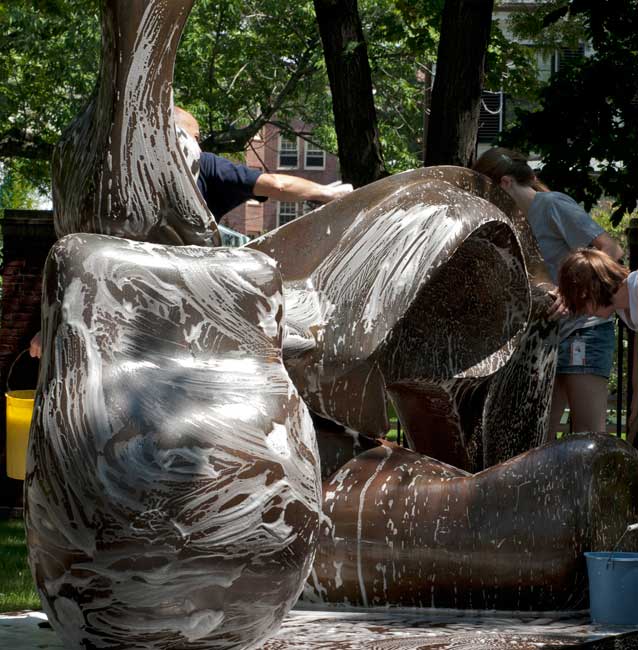Before Henry Moore’s bronze sculpture Large Four Piece Reclining Figure (1972–3) took up its permanent residence outside Harvard University’s Lamont Library in 1981, Seymour Slive, former director of the Fogg Museum, and Derek Bok, then university president, walked around campus with a cardboard replica of the sculpture, searching for an ideal home for the original. Harvard’s Office for the Arts reported in their newsletter that the moment Slive and Bok set the reproduction down in front of Lamont Library, the sprinkler suddenly went off, soaking both the men and the replica (Arts Spectrum 1991).
Sprinklers, snow, acid rain, rival football teams (Daniel Chester French’s John Harvard sculpture has been “decorated” by competitors on more than one occasion)—these are just a sampling of the challenges that face Harvard’s outdoor sculptures. When the university needs specialists to understand, manage, and prevent the degradation of outdoor art, they have a ready resource to call on: Harvard Art Museums’ Straus Center for Conservation and Technical Studies.
The university consults with the Straus Center to care for works such as Moore’s Reclining Figure, Alexander Calder’s Onion (Pusey Library), and a copy of Myron’s Discobolus (Hemenway Gymnasium)—works that are as much a part of campus as the students and visitors who pass by them every day. The Straus Center has performed and coordinated numerous conservation treatments on these sculptures—like the treatment Louise Nevelson’s Night Wall I (Harvard Law School) recently received—keeping these objects on view, year after year.
Snow is an especially aggressive menace (even more so than rain), and our conservators work closely with the university to manage its effects. Snow lingers, and when it sits directly on bronze or marble, it slowly eats away at the material. This is why years ago Henry Lie, director of the Straus Center, recommended covering the marble Chinese dragon stele (Widener Library) and Moore’s Reclining Figure during winter.
Before Reclining Figure gets wrapped each fall, the Straus Center sends a team to prepare the sculpture. They scale the hulking bronze figure, giving it its annual cleaning. After washing it with a mild detergent, they wax it with Butcher’s Bowling Alley Wax and buff it with a cloth. Finally, in the coming weeks, the university will wrap the giant figure in a tailored waterproof cover, protecting it from winter’s inevitable snow.
Beyond weather, the university collaborates with our conservators to attend to the way people interact with public sculptures on campus. Since outdoor sculptures are so easily accessed, people engage with them in ways that aren’t permitted in galleries (as seen in the shine of John Harvard’s left foot, which is polished daily by the bevy of visitors who rub it for good luck).
Seymour Slive and Derek Bok had access in mind when they were seeking a proper home for Moore’s sculpture. Slive recalls how they “chose the place it now occupies because we thought it suits its monumental scale while giving viewers a chance to get close to it.” Over the years, some viewers have gotten so close they decided to climb on the sculpture. Because of the abrasions left by the climbers’ gritty shoes, the Straus Center changed the composition of the coating they apply annually to better protect the sculpture’s physical integrity. Additionally, the university planted ground cover around the sculpture, which has reduced the volume of climbing and other contact.
Henry Moore believed his sculptures should be exhibited in a public setting like that of Harvard Yard—a wish continually granted to the numerous artists who are represented on campus, no matter the season, thanks to the ongoing collaboration between the Straus Center and Harvard University.
“Henry Moore Figures in the Landscape,” Arts Spectrum (January 1991): 4. Newsletter for the Office for the Arts at Harvard and Radcliffe.
On Friday, May 2nd, Harvard Art Museums members can join Research Curator Francesca Bewer for an informative tour of public sculptures on campus as part of our ongoing Harvard Treasures Tours. To learn more about membership and to register for the tour, email am_membership@harvard.edu or call 617-495-4544.


